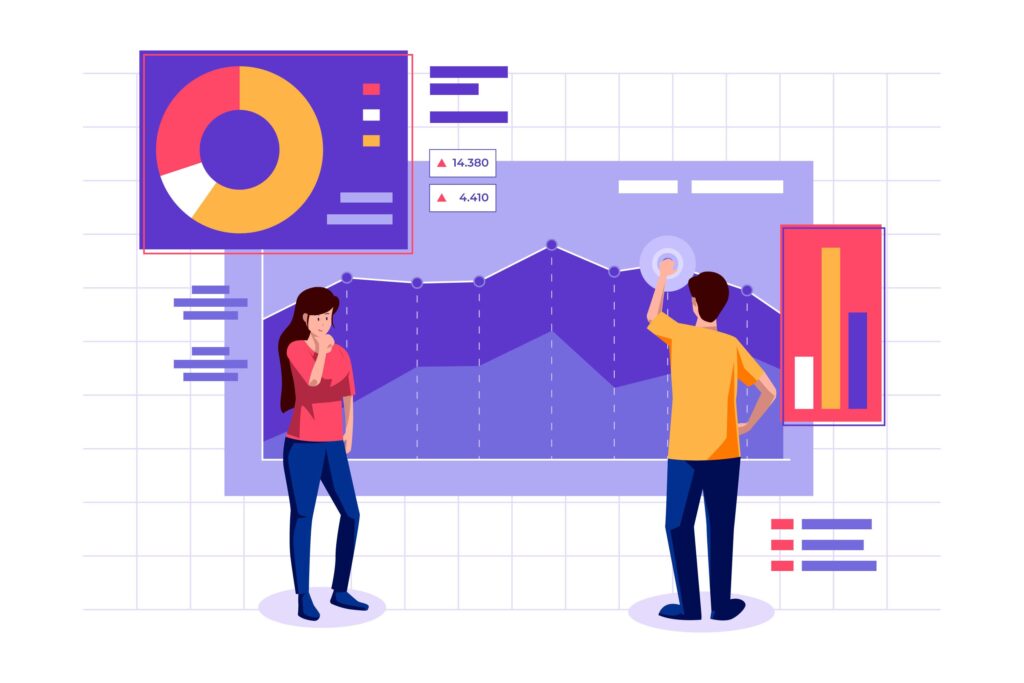Analytics and Reporting
- Performance Tracking: Monitoring key metrics and KPIs.
- Custom Reports: Providing detailed insights and actionable recommendations.
- Data Analysis: Using data to inform and refine marketing strategies.

Analytics and Reporting
Analytics and Reporting are crucial components of any digital marketing strategy, website performance tracking, and business operations. They involve the collection, measurement, analysis, and presentation of data to understand performance and guide decision-making. Here’s an overview of key concepts and best practices related to analytics and reporting.
1. What is Analytics?
Analytics refers to the process of collecting and analyzing data to gain insights about user behavior, trends, and the effectiveness of marketing campaigns, sales, and other business functions. It enables organizations to make data-driven decisions and improve performance.
Types of Analytics:
- Web Analytics: Focuses on understanding website traffic, user engagement, and performance. Examples include Google Analytics, Adobe Analytics.
- Social Media Analytics: Tracks the effectiveness of social media marketing by analyzing metrics such as likes, shares, comments, reach, and engagement.
- Sales Analytics: Analyzes sales data to identify trends, customer preferences, and sales performance.
- Marketing Analytics: Measures the performance of marketing campaigns, including email marketing, paid ads, SEO, and content marketing efforts.
- Customer Analytics: Focuses on understanding customer behaviors, preferences, lifetime value (CLV), and segmentation.
- Product Analytics: Analyzes user interactions with a product, including features used, customer feedback, and conversion rates.
2. What is Reporting?
Reporting refers to the process of summarizing data and presenting it in an easy-to-understand format. Reports can provide insights into various aspects of business performance and help stakeholders understand key metrics, trends, and areas that need attention.
Types of Reports:
- Real-Time Reports: Provides up-to-the-minute data on performance, such as website traffic, campaign progress, or sales metrics.
- Scheduled Reports: Predefined reports that are automatically generated and delivered on a regular basis (e.g., daily, weekly, monthly).
- Custom Reports: Tailored reports that focus on specific metrics or KPIs that are most important to a business or department.
- Executive Reports: High-level reports designed for senior management, focusing on key performance indicators (KPIs) and overall business performance.
3. Key Metrics and KPIs in Analytics and Reporting
Website Performance Metrics:
- Page Views: The total number of times a page has been viewed.
- Unique Visitors: The number of distinct individuals visiting your website.
- Bounce Rate: The percentage of visitors who leave after viewing only one page.
- Average Session Duration: How long visitors stay on the website during a session.
- Pages Per Session: The average number of pages a visitor views during a single session.
- Conversion Rate: The percentage of visitors who take a desired action, such as filling out a form or making a purchase.
- Exit Rate: The percentage of visitors who leave from a particular page.
Social Media Metrics:
- Engagement Rate: The percentage of users who interact with your content (likes, shares, comments).
- Reach and Impressions: Reach refers to the number of unique users who saw your content, while impressions are the total number of times content was viewed.
- Click-Through Rate (CTR): The percentage of people who clicked on a link in your social media posts.
- Follower Growth: The rate at which you are gaining new followers over a specific period.
Marketing Campaign Metrics:
- Email Open Rate: The percentage of recipients who open an email.
- Click-Through Rate (CTR): The percentage of recipients who click on links within an email.
- Return on Investment (ROI): Measures the revenue generated compared to the cost of the campaign.
- Lead Generation: The number of leads generated from a campaign (e.g., form submissions, downloads).
- Customer Acquisition Cost (CAC): The cost of acquiring a new customer through a campaign.
Sales Analytics Metrics:
- Revenue: The total income generated from sales during a specific period.
- Average Order Value (AOV): The average amount spent by customers per transaction.
- Sales Conversion Rate: The percentage of leads or website visitors who become paying customers.
- Customer Lifetime Value (CLV): The total amount of revenue a customer is expected to generate during their relationship with the business.
4. Tools for Analytics and Reporting
Website Analytics Tools:
- Google Analytics: One of the most widely used tools for tracking and analyzing website traffic, user behavior, and conversions.
- Adobe Analytics: Provides advanced analytics and reporting features, including predictive insights and segmentation.
- Matomo: An open-source alternative to Google Analytics, offering powerful tracking and reporting features.
Social Media Analytics Tools:
- Hootsuite: Offers analytics to track social media engagement, audience growth, and content performance.
- Sprout Social: A social media management tool that provides in-depth reports on social media performance.
- Buffer: A platform for managing social media accounts and analyzing post performance.
Email Marketing Analytics:
- Mailchimp: Provides detailed analytics on email campaigns, including open rates, click rates, and conversion tracking.
- Constant Contact: Offers email marketing reports that track open rates, clicks, bounces, and unsubscribes.
Sales Analytics Tools:
- Salesforce: A customer relationship management (CRM) platform with advanced reporting and analytics features for sales teams.
- HubSpot Sales Analytics: Provides data-driven insights into the sales pipeline, lead conversion, and overall performance.
- Zoho Analytics: A tool that offers customizable sales reports, dashboards, and insights into business performance.
5. Best Practices for Analytics and Reporting
1. Set Clear Goals and KPIs
Before you start collecting data, determine what you want to achieve. Whether it’s increasing website traffic, improving conversion rates, or boosting sales, your goals will guide which metrics are most important to track.
2. Track Data Consistently
To make meaningful comparisons and identify trends, it’s essential to collect data regularly. Set up automated reports that allow you to track metrics over time.
3. Ensure Data Quality
Make sure the data you’re collecting is accurate and relevant. Clean, reliable data ensures better insights and informed decision-making.
4. Segment Your Data
Segment your data based on factors like demographics, user behavior, and acquisition sources to gain deeper insights into different customer groups.
5. Visualize Your Data
Use charts, graphs, and dashboards to make your data easy to understand and communicate. Tools like Google Data Studio and Tableau allow you to create visually appealing reports.
6. Interpret and Act on Insights
Analytics and reports are only valuable if you use them to improve performance. Regularly analyze your reports to identify areas for improvement and take action.
6. Advanced Analytics Techniques
- Predictive Analytics: Uses historical data and machine learning algorithms to forecast future trends and behaviors.
- A/B Testing: Tests different versions of a webpage, email, or campaign to determine which one performs better.
- Attribution Modeling: Analyzes which touchpoints or channels contribute the most to conversions and customer acquisition.
- Funnel Analysis: Tracks the path users take from initial awareness to conversion to identify areas where customers drop off.
Conclusion
Analytics and reporting are integral to understanding the effectiveness of your digital efforts. By gathering data, measuring performance, and analyzing results, you can gain valuable insights that guide strategic decisions, improve user experience, and optimize marketing campaigns. Consistent tracking, thoughtful interpretation, and action based on data will ensure your business continues to grow and meet its objectives.

